NRAO eNews
Volume Vol#, Issue Iss#
Day# Month# Year#
NRAO eNews
Volume Vol#, Issue Iss# • Day# Month# Year#

Upcoming Events

ALMA Wideband Sensitivity Upgrade and Other New Capabilities
Mar 16, 2022 | Virtual

Community Webinar Series: (Advanced) Synthesis Imaging with CASA
Mar 24, 2022 | Virtual

18th Synthesis Imaging Workshop
May 18 - 25, 2022 | Virtual

Computational Astrophysics in the ngVLA Era: Synergistic Simulations, Theory, and Observations
Jun 7 - 9, 2022 | New York, NY

The VLA Sky Survey in the Multiwavelength Spotlight
Sep 7 - 9, 2022 | Socorro, NM
Synthesis Imaging Workshop
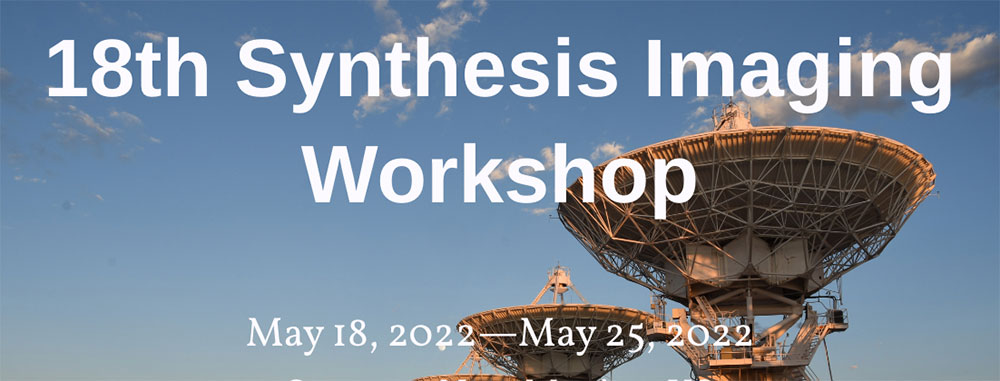
On 18-25 May 2022, the NRAO will be hosting the 18th Synthesis Imaging Workshop. The workshop will be virtual this year. It will consist of a week of lectures on aperture synthesis theory and techniques, and will include tutorials on data collection, calibration, and imaging. Participants should expect an intense week of radio interferometry. Visit the workshop webpage for more information.
VLA/VLBA to ngVLA Transition Advisory Group: Call for Nominations
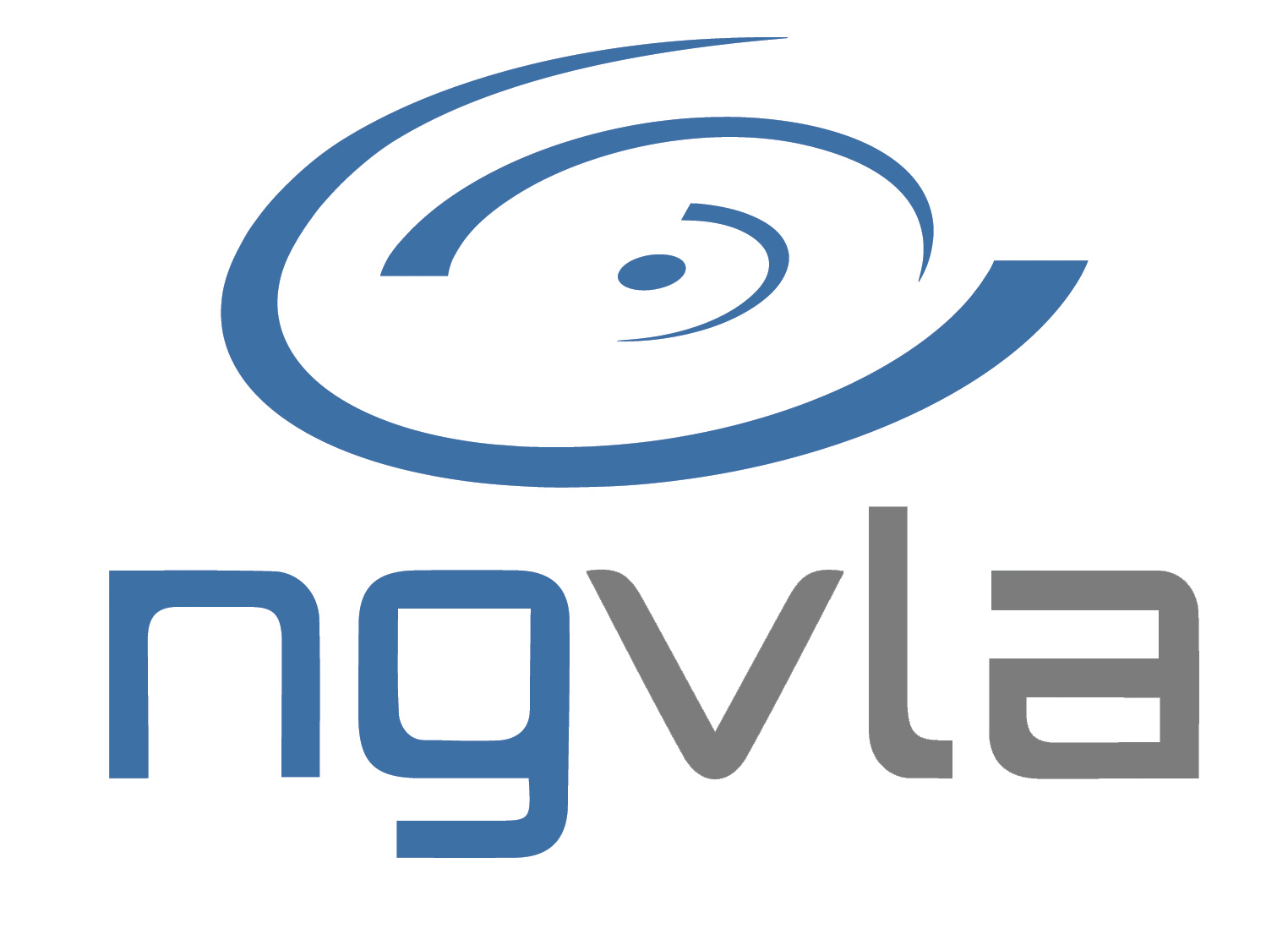
Over the next decade, a number of new facilities (e.g., JWST, Rubin, aLIGO (O4/O5), etc.) will be coming online that will bring with them new science opportunities that will critically benefit from complementary observations at radio wavelengths. Furthermore, stand-alone radio studies provide fundamental and unique information for nearly all areas of astrophysics. This makes it desirable that the U.S. astronomy community consider its scientific needs that require access to the high-resolution centimeter radio sky during this era. Consequently, with the next-generation Very Large Array (ngVLA) recently called out by the Astro2020 Decadal Survey as a high-priority project whose construction should begin this decade, the National Radio Astronomy Observatory (NRAO) is initiating a community-led process to develop a plan to transition from the operation of the Very Large Array (VLA) and Very Long Baseline Array (VLBA) to the ngVLA. Here we request nominations for membership to the VLA/VLBA to ngVLA Transition Advisory Group, which will lead this activity.
Guided by the scientific opportunities planned for the coming decade, this group will be charged to develop, quantitatively assess, and evaluate a finite number of possible VLA / VLBA to ngVLA transition options that can be prioritized on their scientific promise, cost and technical/personnel impacts. The deliverable to NRAO from this group is a summary of their findings, documented in the VLA / VLBA to ngVLA Transition Option Concepts report, which will provide key input to NRAO and National Science Foundation (NSF) planning. The summary report is anticipated to be completed sometime in early 2023.
Nominations are now open. To nominate someone (or self-nominate) please fill out the nomination form.
ngVLA Project News

Computational Astrophysics in the ngVLA Era: Synergistic Simulations, Theory, and Observations
This conference will be held 7-9 June 2022 at the Simons Foundation's Flatiron Institute in Manhattan, New York, USA. It will bring together theoreticians, modelers, and observers to discuss the computational astrophysics and observational challenges for the next generation of observatories, focusing on the next generation Very Large Array (ngVLA). The conference will emphasize the formation of planetary systems, the evolution of galaxies, and the electromagnetic counterparts of gravitational wave events, all fertile grounds for discovery in the next decades and core science goals for the ngVLA. The conference will be in person, but talks will be recorded and made widely available. We particularly encourage the participation of early career scientists.
Registration, abstract submission, and travel support requests opened on 1 February 2022.
Late-time Radio Emission from SLSNe with the ngVLA
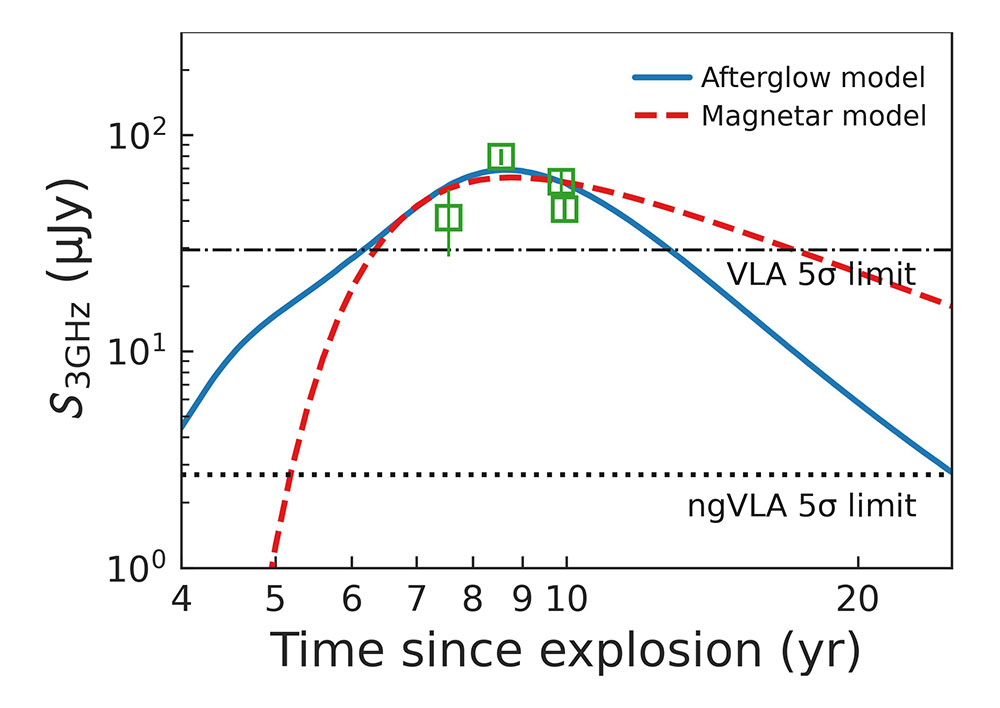
Light curve of PTF10hgi at 3 GHz (green squares), along with models for a magnetar wind nebula (red) and an afterglow (blue), as well as detection limits after a 30-minute integration with the VLA (dot-dashed) and ngVLA (dotted). Adapted from Hatsukade 2021c, ngVLA-J memo series, G001.
[click to enlarge]
Superluminous Supernovae (SLSNe) are very bright explosions (>10-100X brighter) and rare events (<100X lower) compared to ordinary SNe (see Gal-Yam 2012 for a review). SLSNe are a new class of SNe discovered via recent wide-field time-domain surveys, and the power source and mechanism for their high luminosities are still a matter of debate. Radio waves can probe synchrotron emission from SN ejecta or jets shocking the surrounding material, thus providing useful constraints on SLSNe models. Radio observations are also important to study the properties of star formation in SLSNe host galaxies, free from the effects of dust extinction.
In Hatsukade et al. (2021b), we conducted a Very Large Array (VLA) 3 GHz continuum survey toward 23 SLSNe and their hosts, 5-21 years after the explosions, providing one of the largest samples of SLSNe with late-time radio data. We found that the majority of the hosts do not have significant obscured star formation, while four hosts possibly have obscured star formation.
For the first time among SLSNe, the survey revealed late-time variability toward an SLSN, namely PTF10hgi (Hatsukade et al. 2021a). In combination with previous measurements, we constrained both the rise and decay phases of the radio light curve over three years, peaking ~8-9 years after the explosion. The preferred scenarios for the variability are a wind nebula powered by a newly-born magnetar or, given the poor spatial resolution, a low-luminosity flat-spectrum Active Galactic Nucleus in the host galaxy.
To date, ~ 30 SLSNe have radio observations and only a few have radio detections. In addition, the current sensitivity is insufficient to constrain parameters of models for SLSNe or obscured star formation in their hosts. The figure shows the observed 3 GHz light curve of PTF10hgi, along with plausible models and detection limits for the VLA and ngVLA. While the VLA achieves detections only at the brightest phase, the ngVLA will provide more significant constraints over longer periods. High-sensitivity, long-term monitoring observations of a large sample of SLSNe with the ngVLA will enable us to examine the physical nature of SLSNe.
Since 2015 the acronym ngVLA has appeared in 750+ publications indexed in the SAO/NASA Astrophysics Data System. This article continues a regular feature intended to showcase some of those publications. We are especially interested in showcasing work done by early-career researchers. The collection of showcase articles can be viewed online. Anyone wishing to volunteer to author a feature should contact Joan Wrobel.
Cycle 9 (2022) ALMA Ambassadors
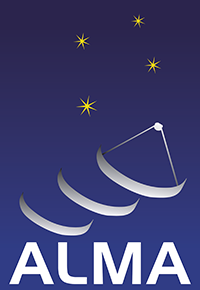
The North American ALMA Science Center (NAASC) is excited to announce the Cycle 9 (2022) ALMA Ambassadors. The Ambassadors program is at the core of the NAASC efforts to reach out to potential ALMA Principal Investigators, and we are grateful for the Ambassadors' contributions to the community. We are looking forward to virtually meeting with the Ambassadors 14-18 February 2022 and working with them on a series of online proposal preparation events. Training will include topics related to ALMA proposal writing and data analysis, including: interferometry basics, ALMA science capabilities, recent ALMA headlines, use of the Observing Tool, and guidance with speaking on these topics.
The ALMA Ambassadors will host a series of workshops targeted at the North American ALMA community–with content similar to a Community Day and NRAO Live! events from previous observing cycles–in advance of the Cycle 9 ALMA proposal deadline in April 2022. Later in 2022, Ambassadors will host community training events focused on ALMA Data Processing and Analysis techniques. Information on these events will be released in a future eNews and made available on the NRAO Community Outreach Events page.
| 2022 ALMA Ambassadors | |
|---|---|
| Ambassador | Affiliation |
| Tarraneh Eftekhari | Northwestern University |
| Hansung Gim | Montana State University |
| Cheng-Han Hsieh | Yale University |
| Charles Law | Harvard University |
| Hayley Roberts | University of Colorado Boulder |
| Nathan Roth | NASA Goddard Space Flight Center |
| Wren Suess | University of California, Santa Cruz and Stanford University |
| Fengwu Sun | University of Arizona |
| Allison Towner | University of Florida |
ALMA Program News
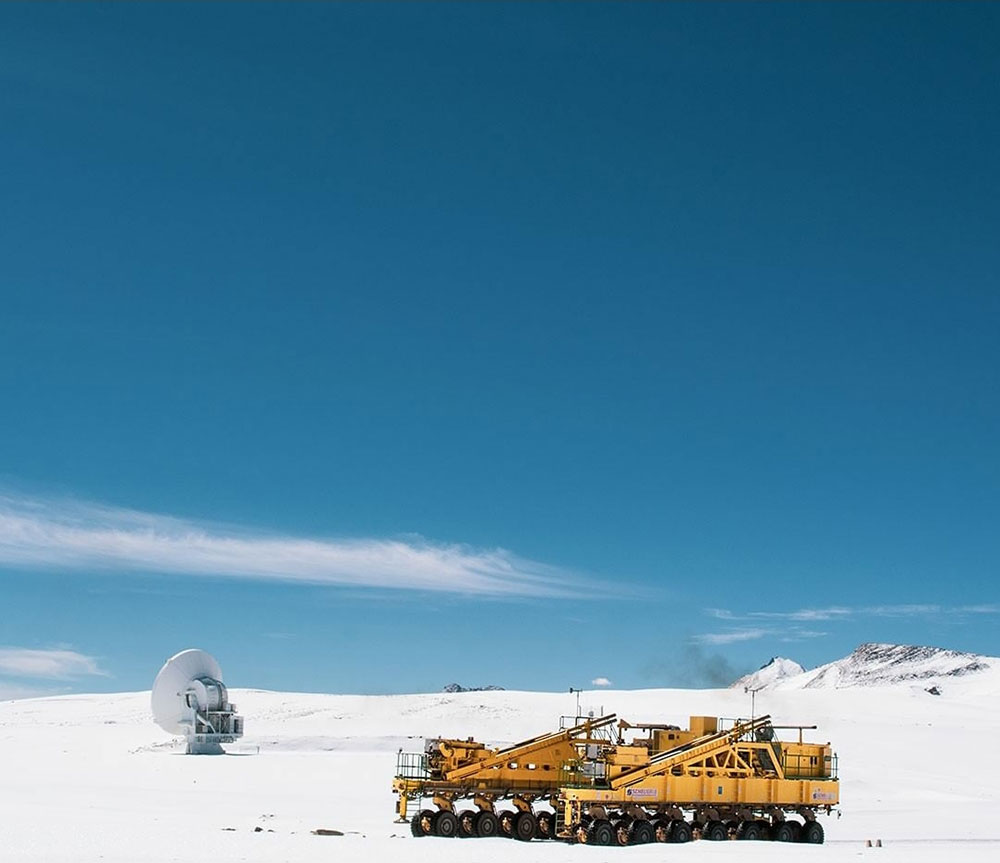
Sergio Otarola
An ALMA antenna and a transporter in typical Altiplanic summer weather.
[click to enlarge]
ALMA Observations
ALMA continues Cycle 8 observations but the normal maintenance shutdown during unstable Altiplanic weather is under way through February. A pre-announcement for the Cycle 9 Call for ALMA observing proposals was issued 15 December 2021. Planned new ALMA capabilities were announced therein, at the almascience.nrao.edu website.
ALMA Status & Wideband Sensitivity Upgrade Progress
Although in December we had understood our planned AAS239 Special Session might be rescheduled to the AAS240 meeting, that is not possible. In its place, the North American Science Center will hold a Webinar beginning at 3 p.m. EDT on 16 March in which speakers will describe ALMA news, capabilities, and expectations for ALMA performance and science in the next few years, and plans for its upgrade in the 2030 timeframe. In that period, ALMA will complete its frequency coverage of the millimeter window. Band 1 (8.6-6.0mm; 35-50 GHz), is being installed on the array now. Band 2 (4.5-3.3mm; 67-90 GHz) will follow, completing installation of the baseline ten bands.
A Band 6 upgrade, part of the ambitious ALMA2030 Wideband Sensitivity Upgrade, is in early stages. This upgrade will improve ALMA's bandwidth and spectral line sensitivity in this most productive band. Eventually, ALMA's bandwidth will be increased to simultaneously enhance its spectral range and continuum sensitivity, even as its line sensitivity is increased via receiver upgrades, an upgraded correlator, and improvements of the systems connecting them. Higher resolution imaging is being explored, both on ALMA's 5000m exceptional site and as part of extremely long baseline imaging arrays. In the Webinar, ALMA Director Sean Dougherty will provide a status report, followed by Program Scientist Crystal Brogan on the planned upgrades. See also the article in this eNews on the Cycle 9 (2022) ALMA Ambassadors.
Robert L. Brown Outstanding Doctoral Dissertation Awarded to Ci Xue

Ci Xue
Dr. Ci Xue
[click to enlarge]
The NRAO and Associated Universities, Inc. (AUI) are pleased to announce that Dr. Ci Xue is the winner of the 2021 Robert L. Brown Outstanding Doctoral Dissertation Award. Dr. Xue's University of Virginia Dissertation, "Discovery and Morphology of Complex Molecules toward Interstellar Molecular Clouds," used observations performed with the Atacama Large Millimeter/submillimeter Array, the Green Bank Telescope, and the Very Large Array to explore diverse star-forming dense clouds in the Milky Way. Dr. Xue developed and applied cutting-edge analysis techniques to uncover weak molecular signals from complex spectral line data. Her remarkable research expands our understanding of the initial chemical conditions of star formation and the voyage of complex organic chemicals as building blocks of bio-macromolecules. The results of Dr. Xue's thesis will guide future projects in astrochemistry for new and powerful instruments to come. Dr. Xue is currently a postdoctoral associate at the Massachusetts Institute of Technology, where she is expanding her dissertation work to study aromatic chemistry in the interstellar medium. The Award presentation and lecture by Dr. Xue will take place in Charlottesville on 28 April 2022.
The Robert L. Brown Outstanding Doctoral Dissertation Award is administered by AUI and the NRAO on behalf of Bob Brown’s family and friends to honor Bob’s life and career. The Award is given each year to a recent recipient of a doctoral degree from any recognized degree granting institution in the United States, and is substantially based on new observational data obtained at any AUI operated facility and considered to be of an exceptionally high scientific standard value and impact within and beyond the area of study.
The Award is available to degree recipients of any nationality and consists of $1000 USD, a framed certificate, and an invitation to give a lecture at the NRAO.
Application Guidelines: To be eligible, the applicant must have successfully defended the thesis during the calendar year of the Award. The deadline for receipt of applications and supporting materials for the 2022 Award is 31 December 2022.
Applicants should send an e-mail to RLBrownAward@nrao.edu providing the following:
- A brief summary describing the major scientific highlights of their dissertation, including to what extent the observations, data analysis, and interpretation were conducted independently by the student;
- A pdf copy of the accepted thesis either sent to RLBrownAward@nrao.edu or made available via a link given in the email;
- The date of their successful thesis defense;
- The name and contact information of their primary thesis supervisor; and
- Published papers or papers submitted for publication, or portions thereof, based substantially on the dissertation.
Verification of the successful thesis defense and statement that the applicant has successfully completed all university requirements for the Ph.D. should be sent directly by the appropriate university authority to RLBrownAward@nrao.edu.
Selection: The applications will be judged on their impact to astronomy and the originality and independence of the applicant’s investigation described in the dissertation. The winning applicant will be selected by a committee appointed by the NRAO Director. If, in the opinion of the Committee, in any given year none of the theses are sufficiently meritorious, the award will not be given in that year. Questions may be addressed to RLBrownAward@nrao.edu.
Public News/Communications Needs Assessment Survey
Education & Public Outreach is conducting a needs assessment of the NRAO communities (staff and users) to help us better understand how our writers, image processors, and artists can help you to succeed at sharing information with the public.
Please take five minutes to fill out our Needs Assessment Survey to help us launch this project and forward to your colleagues and other users of the Very Large Array, Very Long Baseline Array, and the Atacama Large Millimeter/submillimeter Array.
Recent Media Releases
|
NRAO and Optisys Partner Up to Produce 3D Devices for Radio Astronomy |
Inspiring, Retaining and Promoting Female Talent in STEM Careers
|
|
NRAO Researcher Receives Prestigious Engineering Award |
|
|
2021 Science Highlights: Looking Back on a Turbulent Year in Radio Astronomy |
|
|
NRAO Director Tony Beasley Honored as Lifetime AAAS Fellow |
From the Archives
Ellen Bouton

[click to enlarge]
About this month's photo: How many pennies have been flattened on rail tracks over the years? This particular penny is on a commemorative card marking completion of the 1000th Very Large Array (VLA) antenna move on 26 February 1991. (We have no record of how many pennies were flattened for the occasion.) Several employees who had been present for the first antenna move were also present to witness the 1000th. A celebratory luncheon for all VLA site employees followed the final antenna move.
Writing about the 1000th move in the NRAO newsletter for April 1991, Bob Havlen said, "The first documented move of a VLA antenna occurred with a newly bright red transporter nearly sixteen years ago on the 18th of July 1975.... [O]ver the years the VLA antenna crew has shown how experience and dedication can pay long-term dividends. Moves that once took a full day now require only about two hours to complete. The current D configuration is the 34th to be in use (not counting hybrids) since the construction was completed."
From the Archives is an ongoing series illustrating NRAO and U.S. radio astronomy history via images selected from our collections of individuals' and institutional papers. If readers have images they believe would be of interest to the Archives, please contact Ellen Bouton.

